
October is the anniversary month of the fateful battle of the Milvian Bridge.
One has to admire the Uffizi Gallery’s directors, for managing to keep the museum open over the years it is taking to rearrange it into the ‘Grandi Uffizi’, making use of the space in the building on the first floor and at the same time rehanging some of the historic rooms above. All of this goes on with very little notice in the local press and a dearth of comment generally. Even the information office on the ground floor can hardly keep pace: the free leaflet available at fails to illustrate all of the rooms which you can now visit.
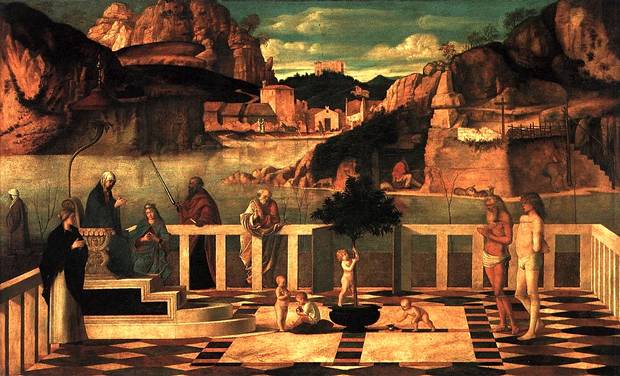
For years the official Room 1, the small room on the right as you enter the first long corridor was closed (or only open on very special request since it displayed ancient Greek and Roman sculpture presumably considered of little interest to the average visitor intent on reaching the Botticelli room as soon as possible). This meant that the visitor itinerary began in Room 2,with the three Maestà altarpieces by Cimabue, Duccio and Giotto. Room 1 was nowhere to be seen.
But just a few weeks ago Room 1 (the sculptures have now moved to Rooms 33 and 34) has been reopened to display the very earliest works in the collection, many of them restored last year, so that one can now understand where the art of Giotto sprang from. The room, now with bright white walls and excellent lighting, is dominated by two Crucifixes, facing each other, both with scenes of the Passion. One dates from c. 1200 or even earlier and the other from c. 1240, and already they clearly demonstrate how medieval art progressed in those years. There are also two panels of a diptych by Bonaventura Berlinghieri of Lucca, who clearly influenced the master of the later Crucifix, and St Francis Receiving the Stigmata, still in its original frame. A very well-preserved painting, which only entered the gallery after its purchase by the Italian state in 2006, is a Madonna and Child Enthroned by the Maestro del Bigallo, named after a work in Florence’s smallest museums (but one of its most enchanting; it is in piazza by the Baptistery). The Madonna Pisa, named after Luigi Pisa who donated it to the gallery in 1933, is a very moving work, as is the serene St Luke the Evangelist displayed beside it by the Maestro della Maddalena. The Redeemer between the Virgin and Three Saints is signed and dated 1271 and preserves its original frame.
At present Room 2 has only the three famous Maestà paintings—and one rather hopes it will stay that way, now that many of the paintings formerly here are re-displayed in Room 1.
Further along the corridor, adjoining the exquisite Tribuna, the next enfilade of rooms (with pretty ceilings decorated in the late 16th century) have been painted white and the works rehung and given good short descriptions, also in English. Room 19 is now devoted to the early Renaissance Sienese School, and the works include a lovely predella by Neroccio dei Landi and a large triptych by Vecchietta.
In Room 20 we skip north to the Veneto, and for the first time Mantegna’s wonderful small triptych with the Adoration of the Magi, Circumcision and Ascension, which preserves its beautiful frame, has been given pride of place against a green panel. But it is in the presence of other masterpieces by him, including the portrait of Cardinal Carlo de’ Medici (also in a magnificent frame) and his tiny Madonna delle Cave. Giovanni Bellini is also very well represented, with three very different works: his mysterious Sacred Allegory, a portrait of a young man (the signature is false so the attribution is also uncertain), and the Lamentation over the Dead Christ, unfinished so left at the chiaroscuro stage. Now fittingly hung here together with works by these two masters are two panels by Antonello da Messina, who worked in Venice for a period and had a great influence on his contemporaries. They were purchased for the gallery in 1996 in accordance with a bequest by Stefano Bardini. They are panels which once belonged to a polyptych and are the only works by Antonello in Florence: stunning paintings on a gold ground, St John the Evangelist and the Madonna and Child (the Madonna has roses in her halo), here displayed to great advantage.
The next three rooms illustrate the art of the regions of the Veneto, Emilia Romagna and Lombardy in the 15th century, and the new arrangement makes comparisons between these painters much more logical, as well as posing questions of reciprocal influences.
So all in all the Uffizi is becoming ever more full of wonderful works, many kept hidden until now in the deposits, and the display is being up-dated to make the visit more and more pleasurable. Note that the telephone booking service (it is always essential to book to avoid the queue) is extremely efficient and quick: and even in late June of this year it was possible to book a visit in the early morning for just a day or two later (T: 055 294883, operational weekdays from 8.30am–6.30pm, and on Saturday 8.30–12.30).
by Alta Macadam. The latest edition of her Blue Guide Florence is available in both print and digital format.
The Portofino peninsula today is a regional park, visited for its stunning views, the special flora and fauna and the microclimate, not to mention the extraordinary geology. It has been, however, for a much longer time a strategic outpost. On a clear winter day one has an unimpeded view stretching from La Spezia to Capo Mele with, in the middle, in the distance, a faint notion of Corsica. The Genoa archives have thick bundles of documents relating to the military use of the location way back in the 18th century. Today’s hikers, though, will not have failed to notice military remains, thick cement constructions, looking decisively much more recent. These are almost undocumented: nothing in the archives, neither in Genoa nor in Germany. But they are indeed a combined Italian and German effort going back to WW2.
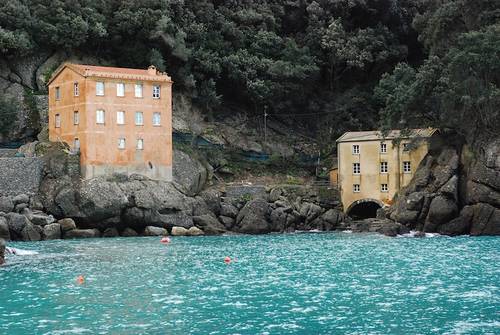
In 1939 the Italian army proceeded to install three guns on the west side of the peninsula in a place known as Erbaio, just above Punta Chiappa. Three concrete platforms were built for the purpose and three guns intended to protect Genoa harbour were installed. They were 6m long, 152/20mm calibre with a 10/15km range. In the autumn of 1943, the German army took over the coastal defences. Beaches were blocked and mined and the German Marine Artillery Command 619 organised a number of batteries in the area: Monte di Portofino was one of them. They were manned by German troops assisted by elements of the Todt Division (Italian civilians doing military work) and some locals.
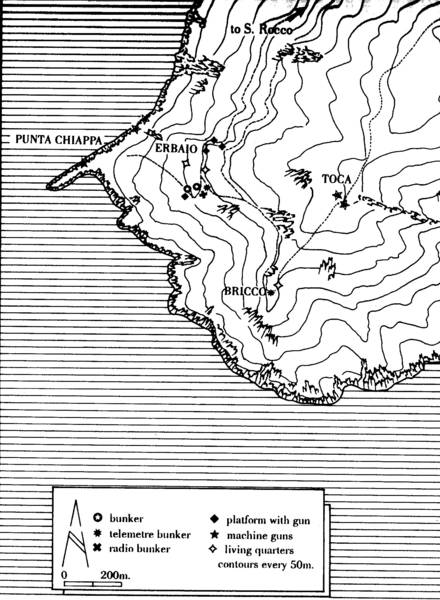
A number of batteries were added and were connected by the very same paths that today’s hikers use, all leading to S. Rocco, the location of the German headquarters in the beautiful villa Giulia (see plan). At sea level Punta Chiappa, the only sea access, was defended by three machine gun station not far from the harbour where the vaporetto delivers its cargo of visitors in summer. Higher up at Erbaio (the path connecting the two locations was better in those days) the existing complex was enlarged with three sentry posts, headquarters, dorms, an infirmary, stores and kitchen, washroom and toilets, and even an open-air altar built in a stone that is not local and painted blue. Huge concrete bunkers (wall thickness 2m, roof thickness 3m) were built to cover two of three guns previously installed by the Italian army. They were grassed over for camouflage. Two smaller concrete constructions (radio bunker and telemetre, i.e. observation bunker) connected by a spiral staircase in the rock were built nearby; camouflage was by hooking nets covered in suitable vegetation. More tunnels were blasted out of the rock to connect the installations and provide ammunition storage. A large graffito warned soldiers not to play with the guns because they might be loaded. There was also room for four additional machine guns. The surroundings were mined.
From Erbaio the Germans built a path to Bricco, a location that affords the best possible panorama of the Gulf of Genoa, and built another observation bunker with tiny living quarters nearby. Fixed machine guns were installed high up at Toca (which is where Semaforo Nuovo is) and at Base O just off the coastal path from San Fruttuoso to Portofino (just look at it, do not try to go there: it is too dangerous).
Erbaio (and probably Bricco as well) had electricity from the generator in the headquarters. Water came via an aqueduct tapping a source higher up. All the plumbing had disappeared by 1947 but the tunnels in which it ran are still there.
Was it all worthwhile? Certainly the effort involved in the enterprise was considerable: everything was hauled up from sea level. The Germans clearly felt that the three big Italian guns would not be sufficient to protect the port of Genoa, foil a possible Allied landing and protect traffic. In those days the bombing of the railways and the submarines lurking in the depths meant that a lot of goods were moved by rafts hugging the coast. But in the end, it did not make a scrap of difference. That already became clear in 1941 when a submarine sunk a merchant ship, the Ischia, under their very noses just off Punta Chiappa. Genoa harbour was repeatedly bombed. The three big guns never fired a single shot and vast quantities of ammunition were found, unused, stacked in the tunnels at the end of the war. As legend has it, relations with the locals were pretty good. The Germans—some 70 of them—were allowed to leave unmolested at the end of the war. Some even maintain that the commandant married a local girl, one of the 40 or so civilians that commuted daily from S Rocco or Punta Chiappa to do the cooking, the laundry and other menial jobs. That’s possibly stretching it a bit. But they certainly went home with a fabulous tan.
by Paola Pugsley, author of Blue Guide Crete and three e-chapters on Turkey. The Portofino peninsula and San Fruttuoso are covered in the Blue Guide e-chapter on Liguria, by Paul Blanchard.
Dull? London? Says who? What happened to the spirit of Dr Johnson, to the tired-of-London-tired-of-life, almost jingoistic belief that home was best?
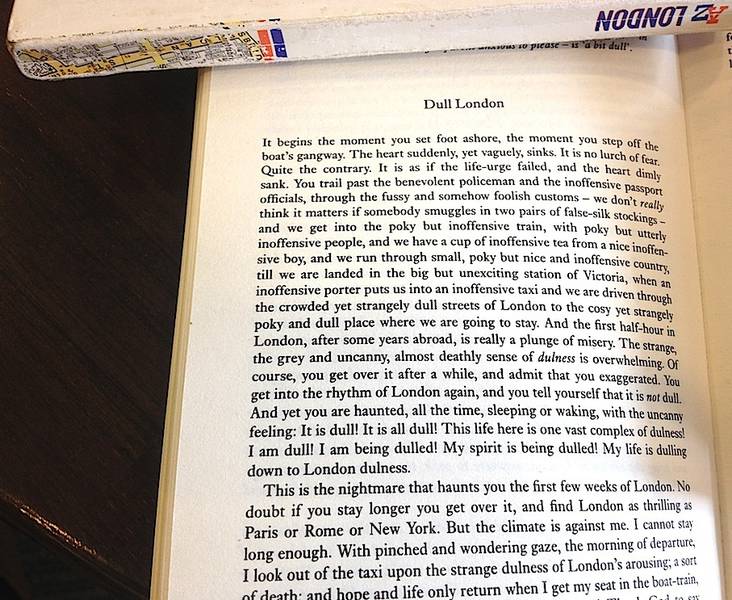
Anyone who has read Paul Fussell’s brilliant Abroad: British Literary Traveling between the Wars, will know the answer. Nineteenth-century escapees, such as Browning, enthused in torrents over Italy or France but that did not mean they also felt the need to express a pitying scorn for home. The Victorians were positive like that. It was in the 20th century, self-loathing set in. With the likes of D.H. Lawrence.
It was Lawrence who wrote the text in the above photograph. Perhaps he had a reason to be contemptuous of England, the country whose Daily News had dismissed his Rainbow as a ‘monotonous wilderness of phallicism’. Perhaps he had been schooled by Byron, whose Venetian poem Beppo dismisses shy and square English girls: ‘The nursery still lisps out in all they utter—Besides, they always smell of bread and butter.’ E.M. Forster trumpeted this sentiment to the echo. England equals repressed. Italy, the continent, equals LIFE, LOVE, PASSION, FREEDOM, SELF-EXPRESSION.
It’s time for the 21st century to assert itself. London is far from dull. To get there, you pass a stony-eyed passport official (certainly not an inoffensive one) who feigns a friendly interest but her questions are pointed and personal. You’re on edge from the start. And the train? From Heathrow? Long and snaking, packed with bags and baggage, a veritable caravan, filled with a rainbow array of people all revealing trivial yet fascinating snippets of multifarious lives on their mobile phones. Coffee was offered by a small man wheeling a trolley. I could only begin to guess what country his ancestors came from. The station, when you get there, is big, madly busy, silently scurrying. Porters are non-existent; taxis are big and black and of a kind unique in the world, an adventure in themselves to travel in. The streets are crowded, yes; familiar but madly exotic, filled with the scents and sounds and accents of all the globe. And if your hotel is poky and dull and you feel your spirit being dulled—well, that is really your own fault.
D.H. Lawrence! thou shouldst be living at this hour. London has something to show thee… He probably wasn’t carrying Blue Guide London, 18th ed. 2014.
The town of Gorizia stands on the Slovenian border in an expansion of the Isonzo valley, hemmed in by hills. It is a peaceful little town with public gardens and buildings in the Austrian style. After the fall of the independent counts of Gorizia in the 15th century, the city remained an Austrian possession almost continuously from 1509 to 1915 and its atmosphere is entirely Central European, despite the street names recalling heroes of the Risorgimento and Italy’s victories against Austria: Garibaldi, Mazzini, Diaz, Cadorna. In the First World War it was the objective of violent Italian attacks in the Isonzo valley and was eventually captured on 9th August 1916. Lost again in the autumn of 1917, it was finally taken in November 1918. The Treaty of Paris (1947) brought the Yugoslav frontier into the streets of the town, cutting off its eastern suburbs, but in 1952, and again in 1978–9, more reasonable readjustments were made, including a 16km-wide zone in which local inhabitants may move freely.
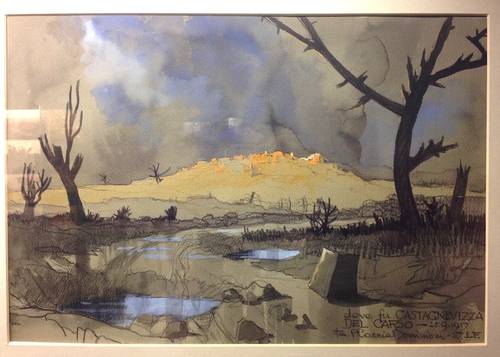
The attractive, wide Corso Italia, lined with trees and some Art Nouveau villas, leads up into the centre of the town. The Palazzo Comunale was built by Nicolò Pacassi, court architect to Maria Theresa, in 1740; it has a public garden. The cathedral is a restored 14th-century building which contains a high altarpiece by Giuseppe Tominz (born in Gorizia in 1790).
Approached on foot by steps up through the walls and past a garden is the peaceful Borgo Castello, built by the Venetians in 1509. Here you will find the Museo della Grande Guerra, one of the most important museums in Italy dedicated to the First World War. Excellently displayed in ten rooms, it has the reconstruction of a trench, and the material illustrates both the Italian and Austrian fronts in the Carso campaign: what makes the displays all the more poignant is the fact that this part of Europe, which today belongs to Italy, was in 1914–18 fighting bitterly for the doomed Austro-Hungarian empire of Franz Joseph, of which it formed a part. A poster of the whiskered emperor adorns the wall of a mocked-up conning tower, exhorting his troops to bravery in action. Enamel badges in the display cases proclaim defeat and humiliation to the English, the Serbs and the perfidious Italians. The watercolour which appears at the top of this piece was painted by Paolo Caccia Dominioni, a lieutenant in the Italian army, who saw action at Castagnevizza and whose brother Cino was killed in a later battle.
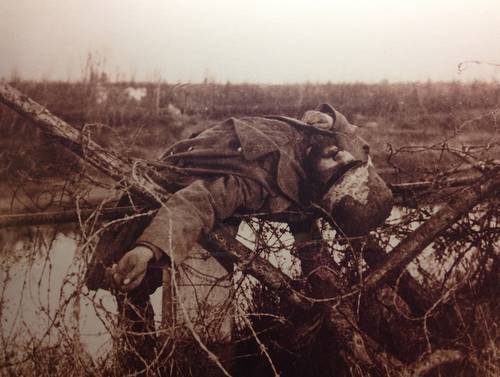
The above text includes an extract from the Blue Guide e-chapter to Friuli-Venezia Giulia. © Blue Guides. All rights reserved.